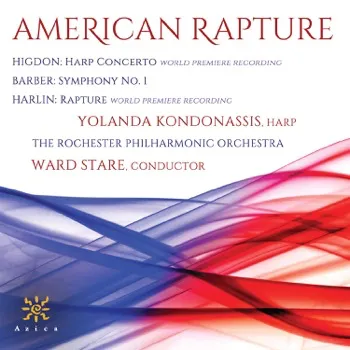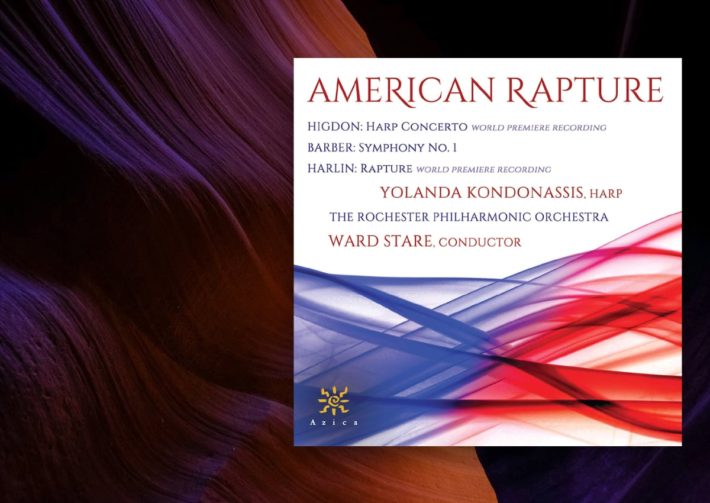This American-centric program contains two world premiere recordings; Jennifer Higdon’s Harp Concerto, written and dedicated to soloist Yolanda Kondonassis, and Patrick Harlin’s “Rapture” for a symphonic orchestra. In between these new contemporary pieces, we have a performance of Barber’s first Symphony in one movement, Op. 9.

You have to give it to Jennifer Higdon’s approach of writing concertos, expertly exploiting each instrument’s inherent qualities, as seen in her Pulitzer winning Violin Concerto or her more recent Viola and Oboe Concertos. Her new Harp Concerto is a 20 minutes, four-movement piece, with a slow solo introduction followed by a development of roughly two themes, then 3 more movements in a fast-slow-fast character. Higdon is many times described as an “intuitive” composer, preferring musical flow and melodic purposefulness to a classically-styled composition technique, yet this new piece seems more organized than her previous concertante attempts.
The second movement (“Joy ride”) takes on specific groups in the orchestra to create a fun dialogue with the soloist, a little reminiscent, perhaps, of Bartók’s Concerto for Orchestra, while in between segments the strings gives a rhythmic context played with mutes.
“Lullaby” is taken to the chamber sphere, with Kondonassis interchanging ideas with soloists from the orchestra – first the Viola and then the Flute, in a clear homage to Debussy’s Sonata for Flute, Viola and Harp. Then come other soloists, all charmingly participating in the intricate play.
Going Into the Cave
Another attractive piece is “Rapture” by Patrick Harlin, which closes the album. Apparently, there is a phenomenon among cave explorers, which can occur while spending long stretches of time underneath the ground and resembles what the composer describes as “a near-religious experience”. This piece tries to capture this phenomenon by slowly rising in orchestration and musical genres to a chaotic climax.
Samuel Barber’s First Symphony in one movement (Op. 9) is a surprising triumph, with a performance as persuasive as we had in many years. In fact, not since Neeme Järvi and the Detroit Symphony Orchestra’s performance for Chandos in the late 1990’ did we have as dedicated and convincing account as this. The Symphony has its weaknesses, especially in the orchestration, which can sound a bit uneven at places. Yet the Rochester Philharmonic under their chief Ward Stare compensates with rhythmic vitality and an exemplifying playing by the string section, with a real sense of purpose by all of the orchestra’s sections, leading to the high point at the end of the single movement (try from 16:00 onward). Also, there are some uncanny resemblances in terms of stylistic writing to Higdon’s new piece (7:40). One wonders if this programming was not based merely on national similarity.
The recording is close and detailed, yet can be a little dry in the climaxes, which may be attributed to the rather dry acoustics of the Kodak Hall at Rochester, where this program was recorded on several concerts in September 2018. In any case, this new album, with an exhilarating performance of the first Barber Symphony and two terrific new pieces, is a highly enjoyable listening experience. Recommended.
“American Rapture”
Higdon – Harp Concerto
Barber – Symphony No. 1 (“in one movement”), Op. 9
Harlin – “Rapture”
Yolanda Kondonassis – Harp
The Rochester Philharmonic Orchestra
Ward Stare – Conductor
Azica Records, CD 9-28-18 TD




















